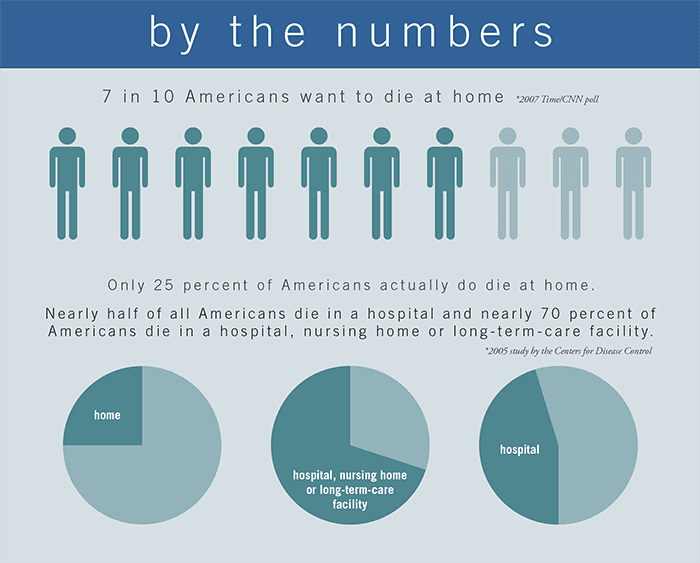Published on September 1, 2017
Creating cultural shift around dying, death and grief on a national scale
Modern Americans are in the throes of a crisis of denial that Alive Hospice understands all too well.
For decades, Americans have been afraid of dying, afraid of grieving and fleeing them both. With the best of intentions, influential medical and religious institutions aid our flight. They encourage us, at all costs, to never “give up” – as if death and grief are avoidable rather than inevitable facts of life.
The crisis in which we find ourselves is doing irreparable harm to millions. People are dying in pain and misery with tremendous suffering, emotionally and spiritually. Families are wracked with guilt and at odds. Even so, we continue to spend billions to prolong the lives of those who are terminally ill regardless of the toll it takes on everyone involved.
In Atul Gawande’s recent commencement address at the California Institute of Technology, he challenged all the students that, as graduating scientists, they had a responsibility to look at scientific research critically and to have a broader view and understanding of reported results. He challenged them not to take just one study as fact and spoke of the need to look behind the data at the systems and processes that defined the science as well.
Ultimately, he closed his remarks with the following words:
“Even more than what you think, how you think matters. The stakes for understanding this could not be higher than they are today, because we are not just battling for what it means to be scientists. We are battling for what it means to be citizens.”
As a scientist himself, he practices general and endocrine surgery at Brigham and Women’s Hospital. Through his best seller, Being Mortal, he shares his perspectives as summarized below:
Medicine has triumphed in modern times, transforming the dangers of childbirth, injury, and disease from harrowing to manageable. But when it comes to the inescapable realities of aging and death, what medicine can do often runs counter to what it should.
Through eye-opening research and gripping stories of his own patients and family, Gawande reveals the suffering this dynamic has produced. Nursing homes, devoted above all to safety, battle with residents over the food they are allowed to eat and the choices they are allowed to make. Doctors, uncomfortable discussing patients’ anxieties about death, fall back on false hopes and treatments that are actually shortening lives instead of improving them. And families go along with all of it.
More and more people are crying out for change, for a return to a healthy acceptance of death and embrace of grieving, no matter how long or in what way. They are tired of having to fight for these things. They want those who wield influence in the realm of dying, death and grieving to make systemic change.
But who will step forward next?
Alive did and can and will again.
The crisis in which we find ourselves is doing irreparable harm to millions. People are dying in pain and misery with tremendous suffering, emotionally and spiritually as well.
We have the experience, the perspective, and the reputation to be the leading national voice spearheading a movement to end this crisis – to restore sanity and dignity to the way Americans die and grieve. We also know that doing so will allow us to increase the quality and quantity of the services we offer.
How do we go about accomplishing this lofty but necessary goal? We acknowledge that this will be a 5-year plan of deliberate intentions and steps that are edgy, progressive and forthright to “force” our communities to think – to think differently about this space of dying, death and grieving.
We have already begun and found the first step to be one of the most important: research. What is already out there, who is saying what and how are messages being shared? What role do traditional media play versus the exploding social media platforms?
What we know
Earlier this year, we conducted a digital analysis that revealed a high volume of conversations about dying, death and grief today. These are largely driven by personal stories. While there are many people – physicians, nurses, chaplains, artists, spouses, parents, children – sharing their perspectives, there is no dominant source leading the conversations, and hospice organizations are virtually absent from the dialogue.
A competitive analysis showed that many hospice providers are in stasis. They are using the same words, messages and images that they have employed for decades, and are nearly indistinguishable from their competitors and peers. They are not reaching the public with needed leadership on dying, death and grief.
Focus groups and interviews with 50+ Alive employees, board members, donors, volunteers, family members and referring health care providers showed that Alive’s supporters understand well the misconceptions about dying, death, grief and hospice that persist. And they are eager to see Alive lead a new effort to boost utilization of its services and change the national conversation – to change lives – for the better.
Many hospice providers are in stasis. They are not reaching the public with needed leadership on dying, death and grief.
Before we can work to create change, we must first understand that which already exists. What we know:
- There is a divide between what the media report, particularly with respect to traditional medicine, and what people are really talking about and concerned about;
- There is a safe but stagnant conversation permeating the industry, characterized by euphemism;
- There is unity among our own community of believers that hospice and grief support are an antidote to fear, capable of restoring sanity and dignity to end-of-life experiences.
These research conclusions confirm:
- The extent of the crisis;
- The need for change that requires bold vision;
- The source from which leadership must come.
We understand that initiating and advancing a movement to reframe the conversation around end-of-life and, ultimately, impact behavior, will take years to achieve. We willingly make this commitment because we believe in the transformative power of hospice and grief support, particularly when people enter into hospice willingly and soon enough in the dying process to experience the benefits; and are provided with grief support readily and with no expectations that their mourning will proceed in a neat, linear fashion.
We are certain that forging ahead with “The Time Has Come,” our integrated, multifaceted plan to succeed over time, is one of the most worthwhile strategies Alive will ever undertake.
This is our vision. What follows is our plan to achieve it.
Where we are heading
We stand at a threshold, and we have the opportunity – quite frankly, the responsibility – to create the change we wish to see in the world. IT IS TIME.
We will launch a new brand, message and mindset of Alive through an integrated, comprehensive 5-year strategic plan that achieves, among others, the following goals:
To build and lead a bold movement that gradually but relentlessly:
- reframes the national conversation about dying, death and grief;
- positions hospice as the conduit for positive end-of-life experiences;
- generates exponential audience endorsement; and
- ultimately leads to systemic change in the way we die.
To elevate Alive as the leading provider of and expert on end-of-life issues by raising awareness of its:
- fearless, fresh perspective;
- groundbreaking research; and
- innovative services locally, regionally and nationally.
To reinforce confidence in Alive and adoption of its services as it expands its geographic and programmatic footprint by:
- personally connecting with those on the local level;
- energizing them with a new and liberating message about dying, death and grief; and
- compelling them to advocate for or make systemic change.
In this publication, you will see many of the strategies already implemented or are in progress that are foundational to achieving this vision.
The Time Has Come and The Time is Now – but we cannot do it alone. As a community, I hope that you will support our efforts in personal connections, attend outreach events, offer to host house parties, make personal and professional connections, share traditional and social media, and consider support for funding these strategies.

